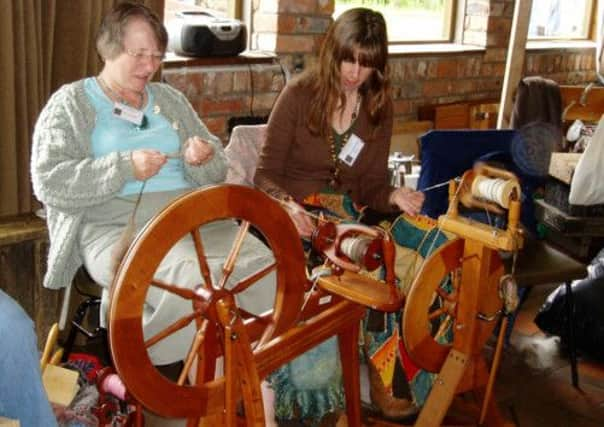Craft skill weaves strands of history


Heidi Svensgaard, who owns the End Cottage Veterinary Practice in Howden and keeps sheep on her smallholding, joined the guild last year in the hope that she’d be able to put the fleeces from her own small flock to good use.
Heidi, who breeds Blue Faced Leicester and Shetland crosses, and rates their wool highly because it’s ideal for spinning, said: “I started keeping sheep three years ago. I breed them for meat but wanted to learn how to make use of the wool too.”
Advertisement
Hide AdAdvertisement
Hide AdShe finds the guild’s meetings a relaxing escape from her busy day job as a vet: “It’s an opportunity to practice traditional skills and crafts from around the world. At my very first meeting I tried my hand at Nordic knitting and I’ve also had a go at knitting with lace weight, a finer wool for delicate items. Many of our traditional skills are being lost in this country, but the guild is very much about sharing and passing them on.
“Absolutely everyone at the meetings is more skilled than me, but we’ve all got to start somewhere. I’m just enjoying learning new skills and I like the fact that making things using wool from your own sheep puts you in control of welfare, traceability and sustainability.”
In one workshop, Heidi learnt how to colour wool using natural plant dyes, boiling it with a mordant to set the dye fast. She shows me two balls of wool – one dyed with blackberries and the other using the skin of just one onion. The depth of colour is surprisingly rich and beautiful.
The guild draws its members from across the North East of England, with some travelling from as far south as Lincoln. Its meetings take place at the Yorkshire Museum of Farming in York once a month. One month there’s a skills workshop and the next there’s a guest speaker.
Advertisement
Hide AdAdvertisement
Hide AdHeidi explained: “I’d say that about half of the guild’s members have their own sheep, like me, and for the rest it’s about their enjoyment of spinning and weaving. Producing wool is very much a hobby for me; there’s no money in it as it’s so costly to get your fleeces spun. I sell some of my wool from a shop on The Shambles in York – the Canadian and US tourists go crazy for Yorkshire wool and are prepared to pay a fair price for it. Unfortunately, there is less demand for it in this country. People just aren’t prepared to pay for it, yet a quality wool sweater will last a lifetime if it’s well cared for. I’m hoping to learn to hand spin on a spindle or wheel so that I’ll be able to do that part of the process myself too.”
The guild’s Chairman, Hazel Antill, first became involved around eight years ago following the death of her mother. She explained: “My parents and aunt belonged to a guild during their retirement, so the interest was there within the family. When my mother died, I was left with all her equipment and decided that it was either a case of selling it or using it. She had three spinning wheels and two or three looms – she dabbled in all of it.
“I decided to take myself along to an open day run by the York guild. I now spin, and I’m learning to weave and dye. We have skill share days to help teach one another these skills. Some people have been members of the guild for a very long time and are very qualified, especially the weavers; they really are experts. It takes a long time to get really good at spinning, although you can produce a thread after a short time. Our most skilled members produce some really beautiful pieces of work.”
Hazel explained that, whereas the members of the medieval guilds would have been traders involved in buying and selling wool, today’s guilds are very much about people practising these ancient crafts for their own enjoyment and, at the same time, helping to keep the skills alive.
Advertisement
Hide AdAdvertisement
Hide AdShe added: “One of the guild’s main aims is to promote the crafts of weaving, spinning and dyeing to a wider audience. However, many other aspects of textiles are of interest to our members, everything from the history of textiles and its tools to knitting, embroidery, silk painting, crocheting, braiding, felt-making, lace-making, textile painting and designing.
“We’re trying to appeal to a younger audience and last year we attracted a lot of new members, but I think that’s because crafts like knitting and felting are becoming very fashionable.
“Also, people are beginning to realise how fantastic wool is to work with. In cold weather, wool is so much warmer. Our wool is exceptionally good in this country, in times past it brought great wealth to England.”
The York Guild of Weavers, Spinners and Dyers is affiliated to the Association of Guilds of Weavers, Spinners and Dyers, a national network linking guilds nationwide, which also organises courses and events.
Advertisement
Hide AdAdvertisement
Hide AdFor more information or to enquire about joining the York guild, visit: http://www.yorks-guild-wsd.org.uk
The Association’s website has details of the guilds across the country: www.wsd.org.uk
History of the guilds of York
Guilds are formal groups of people who come together to promote and protect their shared interests. There were two types of medieval guilds; trade guilds regulated the activities of a particular trade or craft and religious guilds were for the spiritual benefit of their members.
In York, the weavers were first recorded as a trade guild in 1163, when they paid the king £10 a year for the privilege. By the 15th century there were at least 80 different guilds in York.